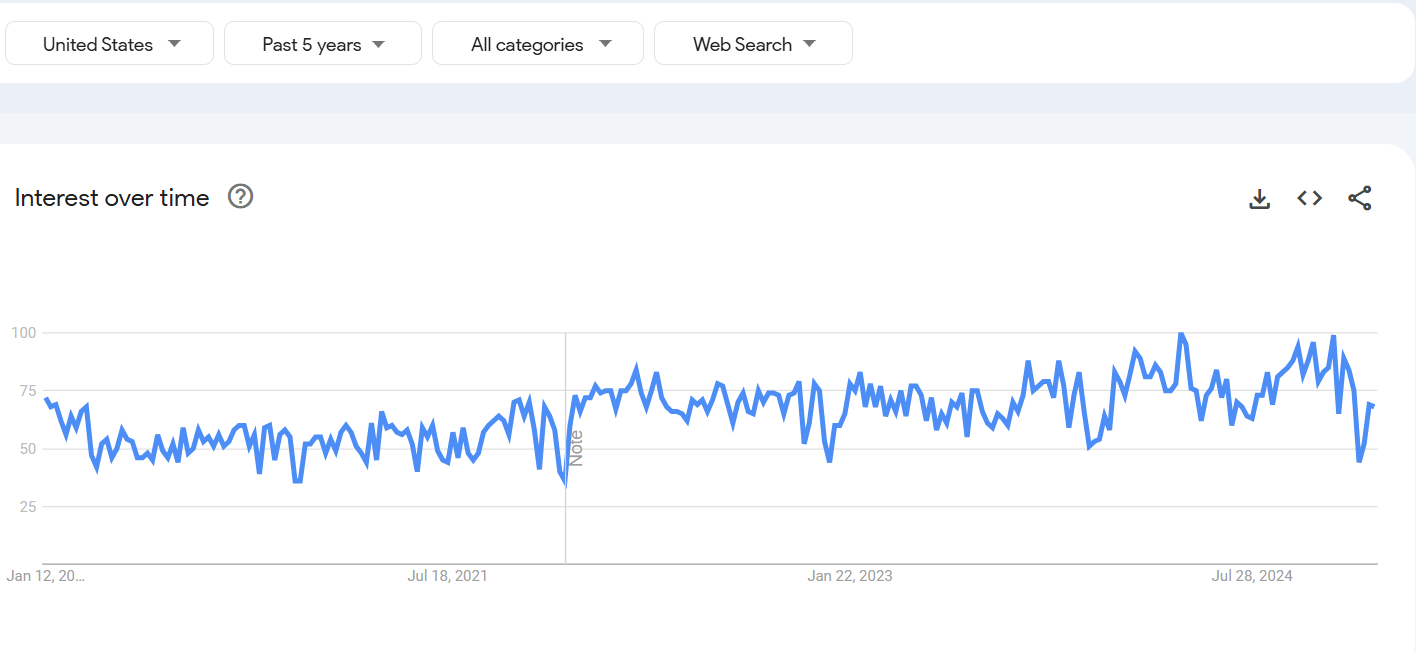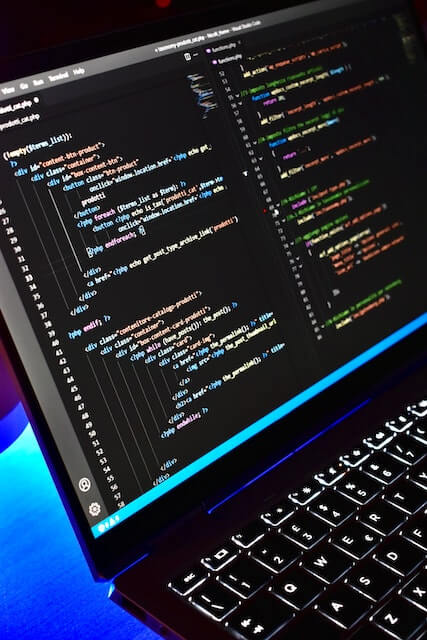
IT Staffing Industry Trends and Challenges in 2025
Expertise and skill gaps are the most notorious obstacles tech leaders face, often delaying product launches and stalling company growth. This trend is especially evident in the lengthy project recruitment process, taking approximately 30 to 70 days to add a senior expert, from posting a job to the candidate’s first day at work.
IT staffing, a division of the broader staffing sector, helps tech leaders by adding talent – such as software engineers, QA experts, or UI/UX designers – to ensure their teams are equipped with the necessary expertise to deliver a project, complete critical or daily tasks, and manage day-to-day development operations.
When it comes to trends, IT staffing has become a trend in itself. A quick search on Google Trends shows unwavering interest in this service: The request has consistently reached peak interest (100 points) over the past few years.

A growing trend for IT staffing 2020-2024
Why is staying on top of current IT staffing trends so important? Simply put, it lets you be one step ahead of skill shortages before they disrupt your operations and have the tools to deal with this challenge.
From AI and Security to current work models and employee retention strategies, we’re ready to break down IT staffing trends that will shape 2025 and beyond. Let’s dive in – because the future won’t wait, and neither should your project.
Key IT staffing trends in 2025
So, what are the most essential IT staffing industry trends you should keep in mind when creating your talent sourcing strategies? For your convenience, we’ve put together all of them in the table below.
| IT staffing industry trends | Key impact | How to adapt it in your organization |
| AI and Automation | AI streamlines your talent acquisition process, automating your time-consuming tasks | Include AI-driven tools like resume parsing and screening in your processes |
| DEI (Diversity, Equity, Inclusion) | DEI values let you access a diverse workforce and expand your talent search | Focus on the inclusive work environment, open culture, and employee training |
| Cybersecurity | You may be faced with an increasing demand for skilled cybersecurity talent in the near future | Invest in upskilling team members and partner with external companies specialized in providing relevant professionals |
| Data-driven recruitment | Lets you make objective hiring decisions based on a variety of data sources | Leverage advanced analytics platforms in your talent acquisition process |
| Digital transformation | Accelerates your staffing processes, improves its efficiency, streamlines candidate evaluation process, and more | Invest in cloud-based workflow automation |
| Employer branding | Attracts and retains top talent by creating a meaningful connection to your mission, values, etc. | Maintain an active online presence, leverage employee testimonials, and focus on onboarding |
| Hybrid and remote work models | Provides greater access to wide pools of tech talent around the world | Create robust policies for remote and hybrid teams and partner with providers of nearshore talent |
| Practical skills focus | Prioritizes candidates with rich commercial experience | Focus on skills-based assessment in your IT staffing process |
| Demand for niche skills | You may be faced with stiff competition for in-demand talent like Data, IoT, Blockchain, etc. | Partner with external providers of specialized talent to source the right profiles faster |
| Economic challenges | You may struggle with the need to optimize software development budgets | Consider alternatives to in-house staffing like nearshoring, staff augmentation, or dedicated teams |
| Integration of Gig economy | Lets you dive in adding freelance or project-based contracts | Create a network strategy for your gig workers |
| Employee well-being | Lets you explore competitive team retention strategies | Adopt wellness programs, flexible work modes, and other employee perks |
| Predictive analytics | Lets you leverage data and analytics to predict and prepare for future staffing trends | Invest in predictive analytics tools to gain hiring insights |
| Skill shortages | Your projects may be affected by a lack of critical skills and expertise | Amplify your recruitment efforts, create a retention strategy, and create external partnerships with tech talent vendors |
With the key IT staffing trends defined, let’s dive into each one individually to see how they will impact your business.
Artificial Intelligence (AI) and automation
One of the key IT staffing industry trends, AI is a true time-saver that helps companies automate mundane tasks like CV screening and interview scheduling.
At least 30% of companies are already using AI-powered tools like resume parsers, chatbots, and ML models to accelerate staffing, create robust workflows, and improve candidate experiences.
Overall, implementing AI is a great way to make better hiring decisions, resulting in stronger, more skilled tech teams.
DEI (Diversity, Equity, Inclusion)
Another essential IT staffing market trend includes prioritizing such values as Diversity, Equity, and Inclusion in your team formation process. For you as a tech leader, it means attracting top talent, given that many senior tech candidates nowadays value a diverse and inclusive workplace.
According to McKinsey, companies in the top quartile for diversity are 27% more likely to outperform their competitors financially. It’s because diverse teams are more creative, innovative, and productive.
Besides that, implementing the DEI strategy lets you tap into much wider pools of candidates, which is crucial for accessing the top talent you’re looking for.
How to achieve that? Guided by DEI values, you can eliminate biases in candidate screening processes, leading to an influx of professionals from various backgrounds who can bring various skills to the table. For instance, staff augmentation in Eastern Europe lets you access over 1 million software engineers with diverse skill sets, problem-solving mindsets, and an inclination to innovation.
Cybersecurity concerns
Cybersecurity has become a critical sector for businesses: according to industry reports, the global cybersecurity market is projected to grow from $217.9 billion in 2021 to $345.4 billion by 2026. Thus, it’s only natural that it has become one of the hottest staffing industry trends.
To ensure your digital infrastructure is Fort Knox in the world full of sophisticated threats, adding specialized talent to your organization is not optional – it’s essential. This often means including specialists with coding skills, cloud security experts, Blockchain, IoT, AI and other talent.
Finding the right profiles for such a demanding role can be tough. The best way to overcome this challenge is by referring to vendors of IT staffing like nCube who can scale your project with the needed talent. Such a partnership can be instrumental in filling up missing skill gaps required to upgrade your security operations.
Data-driven recruitment
The trend for data analysis in IT staffing industry is about providing valuable insights, which ultimately empower tech leaders to make smarter hiring decisions.
Beyond streamlining the staffing process, data analytics can be your sidekick when it comes to predicting a candidate’s performance and retention, leading to a more sustainable tech team you need to launch a product.
Moreover, it excels at enhancing such metrics as time-to-hire and cost-per-hire by identifying inefficiencies in the staffing process. Tools like LinkedIn Talent Insights, Greenhouse Analytics, and Google Hire are second to none in data-driven recruitment.
Digital transformation
One of the IT staffing news is that nearly 99% of Fortune 500 companies use applicant tracking systems (ATS) platforms on a regular basis. This is an indication that digital transformation in the IT staffing industry is in full swing.
ATS is a valuable tool your HR team can use for screening candidates, scheduling interviews, and predicting which candidates will be the best fit for the job.
ATS platforms can play a key role in your business, ultimately reducing your time-to-hire as well as attracting cream-of-the-crop candidates. They significantly enhance the candidate’s experience by streamlining the application process, ensuring efficient, personalized communication.
Employer branding
As an employer, chances are you strive to be the top choice for the best talent. When you aim to secure senior software development talent during times of talent deficit, your company culture, mission, and employee testimonials can make or break your strategy.
Moreover, your brand will attract candidates who resonate with your principles, leading to much higher rates of unforced retention. That way, you’ll create a workplace where employees can thrive and be fully immersed in your project, driving your project success.
Hybrid and remote work models
Another bit of IT staffing industry news – flexible work setups will continue to reign supreme in 2025 and beyond. With that in mind, building robust and clear frameworks for this work model should be a part of your agenda.
The best way is to start by defining your expectations from employees, including working hours, availability, and schedules. Then focus on establishing key performance metrics, data security, and compliance policies.
Don’t overlook employee well-being, as it’s equally important for your in-house and remote employees. Such tools as Asana, Trello, Slack, Jira are best-in-class to achieve success in remote settings.
As a part of your remote work strategy, you can include such arrangements with external providers as {offshore staff augmentation}. Within this model, you can onboard dedicated staff to work on your project from a talent-rich, cost-effective location such as Eastern Europe or Latin America. The provider will take over team formation and retention, while you’ll retain full control over your project.

Focus on practical skills
In the era of constant tech advancements, having a formal degree alone is no longer enough. What truly matters is hands-on skills.
Following this staffing industry trend, most tech giants have already removed the requirement for a degree in many of their job postings.
Skill-based assessment includes evaluating such qualities as the ability to quickly adapt, think creatively, solve problems, and use the most recent technologies. Apart from personal interviews, you can look into candidates’ portfolios, GitHub, and recently completed courses. With this approach, you’ll add professionals with the right competencies to adapt to the challenges of the fast-paced markets.
Increased demand for specialized skills
One of the most exasperating IT staffing industry news for tech leaders is that, according to a McKinsey report, 87% of tech leaders are already struggling with skill gaps or expect them in the near future.
How can you operate effectively during a time of drastic talent shortage? Fortunately, certain approaches, like staff augmentation nearshore, provide access to wide pools of tech talent, including the niche skills your project needs. The talent pool we rely on at nCube includes 125,000 technologists ready to join your project. This lets you source the right kind of talent quickly, accelerating the launch of your project.

Economic challenges
During times of economic turbulence, companies tend to tighten budgets in preparation for a potential recession. For instance, during the 2008 financial crisis, many businesses shifted to more cost-effective staffing models such as outsourcing and contract-based hiring to maintain productivity while reducing expenses.
These trends highlight the importance of flexible and strategic staffing approaches during challenging economic periods. However, chances are, investing in a solid talent strategy is still your number one priority.
If you seek to reduce costs while sustaining quality and rapid delivery, such arrangements as IT {staff augmentation services} or outsourcing can be beneficial. According to Accelerance, outsourcing saves up to 40%-70% of the software development budget. To pinpoint this, below we’ve compared the prices of North American software development market with common nearshoring zones such as Central and Eastern Europe and Latin America.

Note that we at nCube can be your gateway to a pool of software engineers with reasonable rates located in Central and Eastern Europe and Latin America.
Gig economy integration
The gig economy is reshaping the workplace. Going hand-in-hand with this IT staffing trend, you can prioritize flexible pipelines to add on-demand talent to take up your routine software development tasks. This may include project-based staffing or adding freelancers to run day-to-day operations.
You can start implementing this strategy by establishing connections with reliable freelancers via platforms like Upwork. What’s crucial with such a type of staffing is implementing effective management and communication strategies. Just like with your permanent staff, establish clear communication channels, leveraging communication and collaboration tools such as Trello, Asana, Slack, and Jira.
Additionally, you may want to consider implementing incentive programs to motivate your gig workers to exceed expectations.
Employee well-being
It can hardly be called IT staffing industry news for you if you’ve been building teams for a long time, but employees’ well-being has a direct impact on team retention and productivity. Here’s what you can do to boost well-being in your organization:
- Carry out employee surveys;
- Collect feedback during one-to-one interviews;
- Consider improving your turnover rates;
- Measure current employee engagement rates.
To stay abreast with this IT staffing trend, it’s essential to enable a flexible work mode, invest in employee professional development, create wellness programs, and generally cultivate a positive work environment.
Predictive analytics
As a tech leader and a visionary, your superpower is the ability to anticipate and prepare for future needs. By using predictive analytical tools, you ensure your organization stays competitive when it comes to staffing tech teams with top talent.
How to integrate this staffing industry trend into your operations? Below are a few steps to do that:
- Data collection. Collect historical data across various staffing processes, from recruitment to employee retention;
- Data integration. Integrate data sources into a centralized system;
- Select the right tools. Choose tools for data analysis suitable for your industry;
- Engage data scientists or analytics experts. They will help you develop models that can predict your hiring decision outcomes;
- Training staff. Your HR team should know how to leverage these tools and apply them in day-to-day operations.
Workforce shortages
Talent deficit will remain one of the key IT staffing trends for years to come. With that in mind, now is probably the best time to step up your staffing game that will help you attract and retain tech talent. This may include:
- Competitive benefits;
- Opportunities for career growth;
- A positive working environment;
- A healthy work-life balance;
- Regular communication;
- Inclusive company culture.
Challenges in IT Staffing

Tech skill gaps
A lack of talent is the prime reason for companies not meeting their software development goals. As the situation worsens, businesses must come up with effective ways to fill their tech vacancies. Fueled by this IT staffing challenge, you might be looking for smart staffing tactics to attract top talent.
Diving into a global pool of talent is one of the most efficient (and fastest) ways to source top talent. A provider like nCube will give you access to a repository of skilled software developers and offer their expertise in building a remote offshoot of your organization.
We’ll also handle candidate screening, team member integration, talent retention, and overhead – so you can focus on your business.
Adapting to remote and hybrid models
Leading a hybrid team is not simple, especially if you don’t have any prior experience. Thus, when switching to remote or hybrid models, it’s best to be prepared for the following IT staffing challenges:
Communication challenges. When your team is scattered around the world, bringing everyone on the same page can be tough.
Cultural differences. Creating a unified culture and meaningful connections when you run a team with various backgrounds can be one of the biggest IT staffing challenges for a tech leader.
Collaboration. In remote arrangements, your team members will rely heavily on technology to stay productive and overcome remote communication and collaboration challenges.
Performance. You’ll need to ensure your team members have the tools needed to work effectively outside of the company’s physical walls and track their progress constantly.
Adapting to remote work. As a tech leader, you may need to come up with new strategies to make sure remote and hybrid models work as effectively as in-house staffing.
Motivation. Keeping employee motivation high is key for them to stay dedicated and productive in a remote setting.
If you want to overcome these challenges, you can consider working with an external provider who will take care of your team’s well-being and establish effective communication and collaboration processes.
Economic uncertainties
During times of economic turbulence, companies tend to tighten budgets in preparation for a potential recession. However, chances are, investing in a solid talent strategy is still your number one priority.
What should you do to staff projects during hard times like these? Consider the following strategies:
- Implement strategic staffing: Focus on filling critical roles that drive long-term company growth.
- Create employer brand: Prioritize career development and employee well-being as your core values. This will help you attract top tech talent.
- Implement a data-driven strategy: Leverage analytics tools to enhance your staffing strategy and improve hiring decisions.
- Form strategic partnerships: Make a dive into a global pool of talent, which can potentially optimize your software development budget.
Compliance with labor laws
Another IT staffing challenge is navigating global labor employment laws. Due to the rise of remote work, you must handle different tax regulations, unfamiliar legal jurisdictions, and compliance laws for team members located outside your country.
Fortunately, with the help of staffing professionals like nCube who know the nuances of local hiring, you can meet these challenges head-on. We’ll help you ensure legal compliance when you hire teams in Central and Eastern Europe and Latin America. With a team of legal experts, we’ll ensure you remain in full compliance with the local regulations when staffing your project. Moreover, we offer:
- Deep legal research into the market of your interest;
- Assistance with local taxation system;
- Guidance at every step of the hiring process;
- Preparing customized legal contracts for each team member;
- Creating legal entities for your remote branch;
- Crafting all the paperwork and NDAs needed for your employees.
Wrapping up: Key takeaways
For a tech leader, keeping up with IT staffing trends can make a difference between staying ahead or falling behind. With the underlying challenges like tech talent shortage and economic pressure, it’s becoming more and more challenging to staff a project. That said, it’s essential for businesses to embrace data-driven tools, prioritize the values for inclusivity, invest in flexible staffing models, and implement talent retention strategies.
Forming strategic partnerships with providers of staffing solutions can also bring you a competitive edge, helping you access the needed talent and deal with the nuances of remote staffing.
Contact us today to discuss your IT staffing needs and get a tailored solution for your business!
Frequently asked questions about IT staffing industry
What is the IT staffing industry?
IT staffing industry is a subsidiary of the wider staffing sector focused on sourcing talent with the specialized technical skills and experience required for technology roles. This may include such competencies as software development, Quality Assurance, cybersecurity, DevOps, and other roles.
What is the IT staffing market size?
According to the recent IT staffing market insights, the current IT staffing market size is USD 123.30 Billion.
Is the IT staffing industry growing?
Yes, the IT staffing industry is projected to grow to USD 147.58 Billion by 2030 at a CAGR of 3,66%.
What is the outlook for the IT staffing industry?
The market dynamics show that the staffing industry is on a growth trajectory, with 97% of staffing companies anticipating growth in 2025 in the range of 5-20%.
Recommended articles


